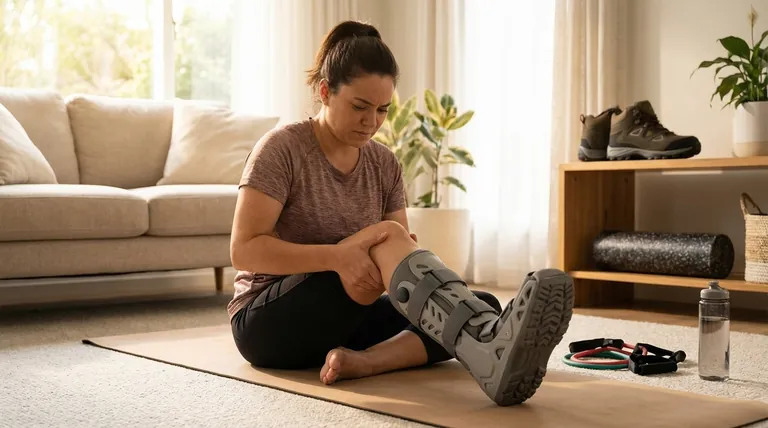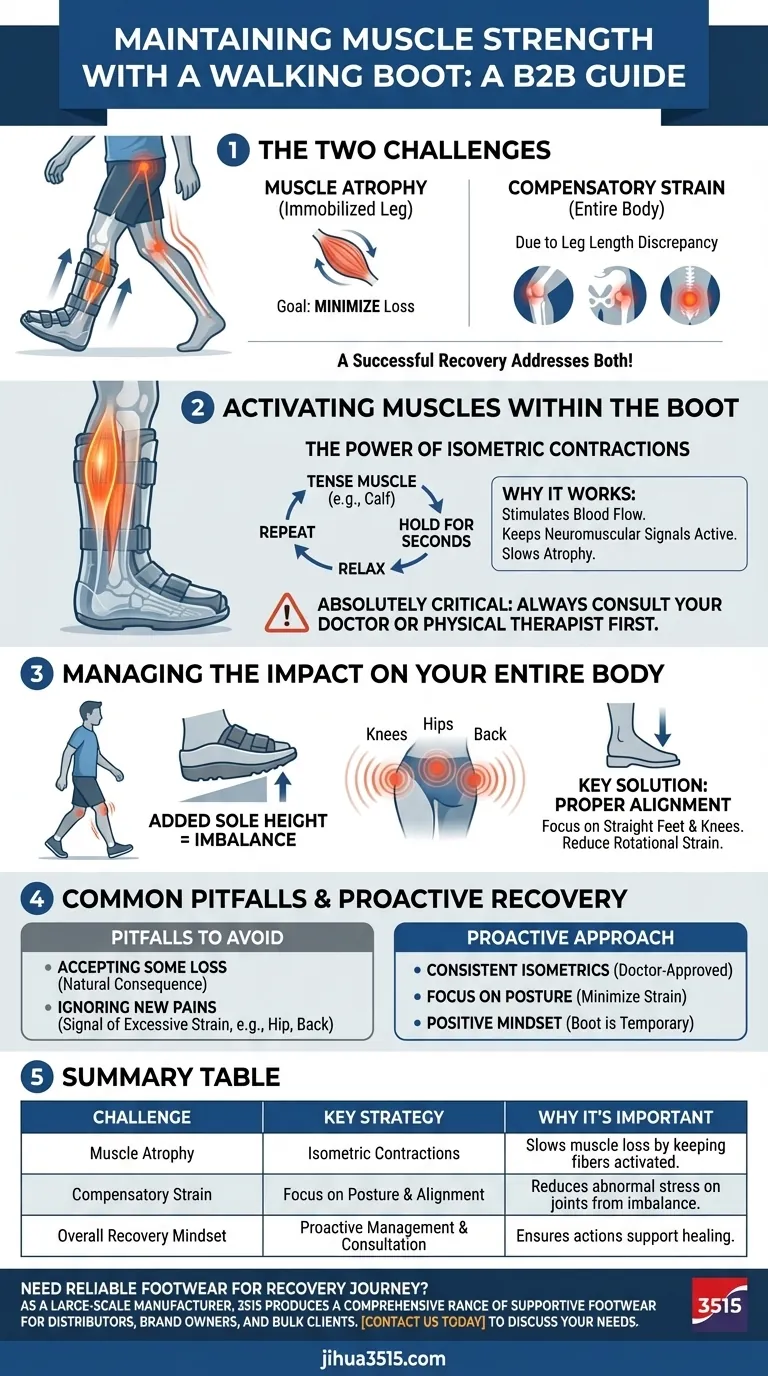To maintain muscle strength while wearing a walking boot, the most common recommendation is to perform isometric exercises, which involve tensing and relaxing the muscles inside the boot without moving the joint. This helps keep the muscles activated, but it is critical to consult your doctor or physical therapist for specific instructions tailored to your injury to ensure you are not compromising the healing process.
A walking boot is essential for healing, but it creates two distinct challenges: muscle atrophy in the immobilized leg and compensatory strain on the rest of your body. A successful recovery depends on proactively addressing both of these issues.

Activating Muscles Within the Boot
The primary concern for many is the visible muscle loss that occurs from immobilization. While some atrophy is unavoidable, you can take steps to minimize it.
The Power of Isometric Contractions
The simplest and safest way to engage your muscles is through isometric contractions. This means you are tightening a muscle without actually moving the corresponding joint.
For example, you can consciously tense your calf or shin muscles for several seconds and then release them. This sends signals to the muscle fibers to remain active, which can help slow the rate of atrophy.
Why This Works
Even without movement, contracting a muscle stimulates blood flow and reminds your neuromuscular system how to fire. This simple action helps maintain a baseline of muscle tone and strength during the period of immobilization.
Always Consult Your Doctor First
Before beginning any exercise, even simple tensing, it is absolutely critical to get approval from your doctor or physical therapist. They can provide guidance based on the specifics of your injury and ensure your actions support, rather than hinder, your healing.
Managing the Impact on Your Entire Body
A walking boot doesn't just affect the injured limb; it disrupts your body's entire kinetic chain. The added height of the boot's sole is often the primary culprit.
The Source of the Imbalance
The sole of a walking boot is typically thicker than a normal shoe, creating a leg length discrepancy. This slight but constant imbalance forces your body to compensate with every step.
The Ripple Effect: Knees, Hips, and Back
This compensation places abnormal stress on other joints. Your knees, hips, and back are particularly vulnerable to new aches and pains as they work harder to maintain balance and absorb shock unevenly.
A Key Solution: Proper Alignment
Pay conscious attention to your walking form. Focus on keeping your feet and knees pointing straight ahead to prevent the twisting motions that can accompany a limp. This simple adjustment helps reduce rotational strain on your hips and lower back.
Common Pitfalls to Avoid
Being aware of the challenges is the first step in overcoming them. A walking boot is a temporary tool, but its side effects can be frustrating if not managed properly.
Accepting Some Muscle Loss
The goal is to minimize muscle atrophy, not eliminate it entirely. It is a natural consequence of immobilization. Focus on what you can control, and trust that you can rebuild that strength once the boot is off.
Ignoring New Pains
Do not dismiss new pain in your hip, back, or opposite knee as "normal." This is your body signaling that the imbalance is causing excessive strain. If you experience this, discuss it with your doctor, as they may suggest solutions like a shoe lift for the uninjured foot.
A Proactive Approach to Recovery
Your mindset and actions during this period can significantly influence the quality and speed of your recovery. Taking an active role is key.
- If your primary focus is preventing muscle loss: Prioritize consistent, doctor-approved isometric exercises to keep the muscles in your injured leg engaged.
- If your primary focus is avoiding secondary pain: Concentrate on your posture and walking alignment to minimize the compensatory strain on your knees, hips, and back.
- If your primary focus is overall well-being: Maintain a positive outlook by remembering the boot is temporary and lean on your support system to stay encouraged.
By actively managing both the injured area and the rest of your body, you can navigate your recovery with greater comfort and confidence.
Summary Table:
| Challenge | Key Strategy | Why It's Important |
|---|---|---|
| Muscle Atrophy in Injured Leg | Isometric Contractions | Slows muscle loss by keeping fibers activated without joint movement. |
| Compensatory Strain on Body | Focus on Posture & Alignment | Reduces abnormal stress on knees, hips, and back from leg length discrepancy. |
| Overall Recovery Mindset | Proactive Management & Doctor Consultation | Ensures actions support healing and prepares you for post-boot strength rebuilding. |
Need reliable footwear for your recovery journey? As a large-scale manufacturer, 3515 produces a comprehensive range of supportive footwear for distributors, brand owners, and bulk clients. Our production capabilities encompass all types of shoes and boots, ensuring you have access to quality products for every stage of rehabilitation. Contact us today to discuss your footwear needs and how we can support your business.
Visual Guide

Related Products
- Safety Footwear Wholesale Manufacturer for Custom OEM/ODM Production
- Customizable Anti-Smash Safety Boots for Wholesale & Private Label Manufacturing
- Premium Wholesale Wheat Nubuck Safety Boot with Rapid Lacing System
- Premium Grain Leather Safety Boots for Bulk Supply
- Premium High-Cut Waterproof Safety Boots Manufacturing & Wholesale Solutions
People Also Ask
- What are OSHA approved shoes? Understanding the Correct Standards for Workplace Safety
- How do safety shoes contribute to cost savings for companies? A Strategic Investment in Risk and Cost Management
- What do heavy duty boots do? Protect Your Feet in Demanding Work Environments
- Is it normal to wear shoes in the house? A Guide to Hygiene, Comfort & Culture
- What are the cultural perspectives on wearing shoes in the house? A Guide to Home Etiquette & Hygiene



















